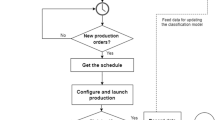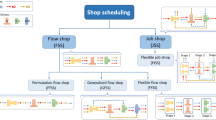Abstract
We study a single-machine scheduling problem in a flexible framework where both job processing times and due dates are decision variables to be determined by the scheduler. The model can also be applied for quoting delivery times when some parts of the jobs may be outsourced. We analyze the problem for two due date assignment methods and a convex resource consumption function. For each due date assignment method, we provide a bicriteria analysis where the first criterion is to minimize the total weighted number of tardy jobs plus due date assignment cost, and the second criterion is to minimize total weighted resource consumption. We consider four different models for treating the two criteria. Although the problem of minimizing a single integrated objective function can be solved in polynomial time, we prove that the three bicriteria models are \(\mathcal{NP}\)-hard for both due date assignment methods. We also present special cases, which frequently occur in practice, and in which all four models are polynomially solvable.
Similar content being viewed by others
References
Armstrong, R., Gu, S., & Lei, L. (1995). An algorithm for the two-resource allocation problem with a non-differentiable convex objective function. Journal of the Operational Research Society, 46, 116–122.
Armstrong, R., Gu, S., & Lei, L. (1997). Solving a class of two-resource allocation problem by equivalent load method. Journal of the Operational Research Society, 48, 818–825.
Alidaee, B., & Ahmadian, A. (1993). Two parallel machine sequencing problems involving controllable job processing times. European Journal of Operational Research, 70, 335–341.
Baker, K. R., & Scudder, G. D. (1990). Sequencing with earliness and tardiness penalties: a review. Operations Research, 38, 22–36.
Cheng, T. C. E., & Janiak, A. (2000). A permutation flow-shop scheduling problem with convex models of operation processing times. Annals of Operations Research, 96, 39–60.
Cheng, T. C. E., Janiak, A., & Kovalyov, M. Y. (1998). Bicriterion single machine scheduling with resource dependent processing times. SIAM Journal on Optimization, 8(2), 617–630.
Chudzik, K., Janiak, A., & Lichtenstein, M. (2006). Scheduling problems with resource allocation. In A. Janiak (Ed.), Scheduling in computer and manufacturing systems. Warszawa: WKL.
De, P., Ghosh, J. B., & Wells, C. E. (1991). Optimal delivery time quotation and order sequencing. Decision Sciences, 22, 379–390.
Hoogeveen, H., & Woeginger, G. J. (2002). Some comments on sequencing with controllable processing times. Computing, 68, 181–192.
Gordon, V., Proth, J. M., & Chu, C. (2002a). A survey of the state-of-the-art of common due date assignment and scheduling research. European Journal of Operational Research, 139, 1–25.
Gordon, V., Proth, J. M., & Chu, C. (2002b). Due date assignment and scheduling: SLK, TWK and other due date assignment models. Production Planning and Control, 13(2), 117–132.
Janiak, A. (1986a). Time-optimal control in a single machine problem with resource constraints. Automatica, 22(6), 745–747.
Janiak, A. (1986b). One-machine scheduling problems with resource constraints. Lecture Notes in Control and Information Sciences, 84, 358–364.
Janiak, A. (1987). One-machine scheduling with allocation of continuously-divisible resource and with no precedence constraints. Kybernetika, 23(4), 289–293.
Janiak, A. (1988a). Minimization of the total resource consumption in permutation flow shop sequencing subject to a given makespan. Modelling, Simulation & Control, 13(2), 1–11.
Janiak, A. (1988b). General flow-shop scheduling with resource constraints. International Journal of Production Research, 26(6), 1089–1103.
Janiak, A. (1989). Minimization of resource consumption under a given deadline in the two-processor flow-shop scheduling problem. Information Processing Letters, 32, 101–112.
Janiak, A. (1998). Minimization of the makespan in a two-machine problem under given resource constraints. European Journal of Operational Research, 107, 325–337.
Janiak, A., & Kovalyov, M. Y. (1996). Single machine scheduling subject to deadlines and resource dependent processing times. European Journal of Operational Research, 94, 284–291.
Janiak, A., Janiak, W., & Lichtenstein, M. (2007). Resource management in machine scheduling problems: a survey. Decision Making in Manufacturing and Services, 1(12), 59–89.
Kahlbacher, H. G., & Cheng, T. C. E. (1993). Parallel machine scheduling to minimize costs for earliness and number of tardy jobs. Discrete Applied Mathematics, 47, 139–164.
Kaminsky, P., & Hochbaum, D. (2004). Due date quotation models and algorithms. In J. Y.-T. Leung (Ed.), Handbook of scheduling: algorithms, models and performance analysis (pp. 20-1–20-22). Boca Raton: CRC Press.
Leyvand, Y., Shabtay, D., & Steiner, G. (2010). On common due date assignment to minimize the weighted number of tardy jobs in scheduling a single machine with controllable processing times. IIE Transactions, 42(3), 221–231.
Monma, C. L., Schrijver, A., Todd, M. J., & Wei, V. K. (1990). Convex resource allocation problems on directed acyclic graphs: duality, complexity, special cases and extensions. Mathematics of Operations Research, 15, 736–748.
Ng, C. T. D., Cheng, T. C. E., Kovalyov, M. Y., & Lam, S. S. (2003). Single machine scheduling with a variable common due date and resource-dependent processing times. Computers and Operations Research, 30, 1173–1185.
Ng, C. T. D., Cheng, T. C. E., Janiak, A., & Kovalyov, M. Y. (2005). Group scheduling with controllable setup and processing times: minimizing total weighted completion time. Annals of Operations Research, 133, 163–174.
Nowicki, E., & Zdrzalka, S. (1990). A survey of results for sequencing problems with controllable processing times. Discrete Applied Mathematics, 26, 271–287.
Scott, S. C., & Jefferson, T. R. (1995). Allocation of resources in project management. International Journal of Systems Science, 26(2), 413–420.
Shabtay, D. (2004). Single and a two-resource allocation algorithms for minimizing the maximal lateness in a single machine-scheduling problem. Computers and Operations Research, 31(8), 1303–1315.
Shabtay, D., & Kaspi, M. (2004). Minimizing the total weighted flow time in a single machine with controllable processing times. Computers and Operations Research, 31(13), 2279–2289.
Shabtay, D., & Kaspi, M. (2006). Parallel machine scheduling with a convex resource consumption function. European Journal of Operational Research, 173(1), 92–107.
Shabtay, D., & Steiner, G. (2007a). Optimal due date assignment and resource allocation to minimize the weighted number of tardy jobs on a single machine. Manufacturing & Service Operations Management, 9(3), 332–350.
Shabtay, D., & Steiner, G. (2007b). A survey of scheduling with controllable processing times. Discrete Applied Mathematics, 155(13), 1643–1666.
Shakhlevich, N. V., & Strusevich, V. A. (2005). Pre-emptive scheduling problems with controllable processing times. Journal of Scheduling, 8, 233–253.
Shakhlevich, N. V., & Strusevich, V. A. (2006). Single machine scheduling with controllable release and processing times. Discrete Applied Mathematics, 154, 2178–2199.
Slotnick, S. A., & Sobel, M. J. (2005). Manufacturing lead-time rules: customer retention versus tardiness costs. European Journal of Operational Research, 169, 825–856.
Strauss, M. (2006). Loblaw to Levy fines in crackdown on suppliers. The Globe and Mail, Toronto, Ontario, Canada.
T’kindt, V., & Billaut, J.-C. (2006). Multicriteria scheduling: theory, models and algorithms (2nd ed.). Berlin: Springer.
Trick, M. (1994). Scheduling multiple variable-speed machines. Operations Research, 42, 234–248.
Vickson, R. G. (1980). Two single machine sequencing problems involving controllable job processing times. AIIE Transactions, 12(3), 258–262.
Wan, G., Yen, B. P.-C., & Li, C. L. (2001). Single machine scheduling to minimize total processing plus weighted flow cost is NP-hard. Information Processing Letters, 79(6), 273–280.
Author information
Authors and Affiliations
Corresponding author
Rights and permissions
About this article
Cite this article
Shabtay, D., Steiner, G. A bicriteria approach to minimize the total weighted number of tardy jobs with convex controllable processing times and assignable due dates. J Sched 14, 455–469 (2011). https://doi.org/10.1007/s10951-010-0208-7
Published:
Issue Date:
DOI: https://doi.org/10.1007/s10951-010-0208-7




